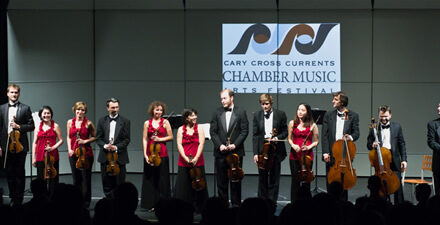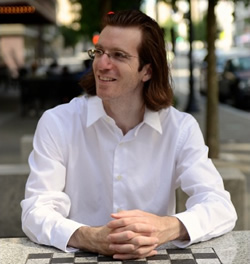Cellist, Timothy Holley, Assistant Professor of Music at North Carolina Central University since 1996 was joined by former colleague and frequent accompanist Alice Tien for a concert Friday evening in the Recital Hall of the C. Ruth Edwards Music Building on the campus of NCCU. Holley received his bachelor of music from Baldwin-Wallace College and earned his master of music and doctor of musical arts degrees at the University of Michigan. Among numerous other artistic activities, he participated in the 50th Baldwin-Wallace Bach Festival in its Kennedy Center debut and gave the first Midwest performance of Lou Harrison’s Double Concerto for violin, violoncello, and Javanese gamelan — with the composer playing the gamelan. His doctoral dissertation focused on the cello music of African-American composers, and he continues to be active in the study and performance of African-American concert music. Alice Tien grew up in Michigan and majored in Piano at the Oberlin Conservatory of Music and attended the Aspen Music School in Colorado with a full merit scholarship. She has been in the Triangle since 1990 involved in teaching and performing and is especially known for her collaborative skills.
The recital “Lost April: A Musical Remembrance of the Hokie Nation and Slava” was explained in detail in the program notes. It began with reference to the song “Lost April” heard in the 1947 motion picture “The Bishop’s Wife” and reused in the 1996 remake as “The Preacher’s Wife.” It reminded us of April 2007 — the infamous Don Imus blather, the Virginia Tech tragedy, and the death of Mstislav Rostropovich.
Gabriel Fauré’s rhapsodic and, at times, wistful Elegie, Op 24 set the mood of the concert with Holley and Tien complementing each other with the qualitative sonority of their respective instruments. Attacks were on the mark; echoed passages matched and expanded what had been played before. It was a warm and comforting rendition from the heart of the French Romantic Era.
Adolphus Hailstork’s 1980 Elegy was made out of the stuff that tears are made from and could only have been written by one who had dipped his pen in the ink of the blues. The very ending was stunning with the piano striking a forceful tone cluster to be followed by the three descending pitches of farewell. The cello has a unique ability in its tonal quality to express the emotions of loss and grief. Much of the repertoire for the instrument makes smart use of this quality. Holley’s skill, rich tone and oneness with the instrument filled the room not only with the sense of sadness such a program calls for, but also with the heroic dignity of resolve and hope.
After a short break, Holley returned to the stage alone to perform the centerpiece, and indeed the highlight of the evening. Sir Benjamin Britten wrote his Third Suite for Cello in the early spring of 1971 as a gift for Rostropovich to be presented on a trip to Leningrad (now St. Petersburg once more) and Moscow. The piece confirms the consummate genius of Britten as a master craftsman of composition. The suite is based on three Russian folk songs and a hymn from the Russian liturgy. It uses nearly every performance capability of the instrument in nine sections played without pause before stating the original material straightforwardly at the end. It is an immensely complex and challenging work, which Holley approached with enthusiasm and obvious affection after relating some of his personal contacts with “Slava” Rostropovich. His mastery of the instrument and interpretation of the score was outstanding and left this reviewer with a sense of awe and satisfaction with both the music and the performance.
After intermission, two of the twentieth century’s brilliant Russian composers were given the stage. With Tien at the piano again we heard Two Pieces (1951) by Dimitri Shostakovich: Adagio (“The Limpid Stream”) and Spring Waltz (“Michurin”), both extracted from the Ballet Suite No. 2. Unstriking, but most pleasant music, both segments reflected the titles picturesquely.
The closing selection was the Sonata in C Major, Op. 119 (1949), by Sergei Prokofiev. He was already ill at this time and would die about three years later. The work reflects the technical influences of Rostropovich, who gave the first performance in 1950. The first movement “Andante grave” has a potentially brooding quality and places demands on the performer to give expression within the limited tempo changes. The middle movement marked “Moderato” however has a playful quality somewhat reminiscent of Peter and the Wolf from many years earlier. The closing movement brings us an optimistic quality ending with a restatement of the opening theme. In this work, the interplay between soloist and accompanist was teamwork of impressive accomplishment. Passing themes back and forth, accompanying development, contrasting textures all added up to a performance of polished virtuosity. It was a rewarding evening of remembrance and discovery and a high honor to the memory of so many of our respective loved ones, the lives lost at Blacksburg and more recently in Minneapolis, and to “Slava.”.












